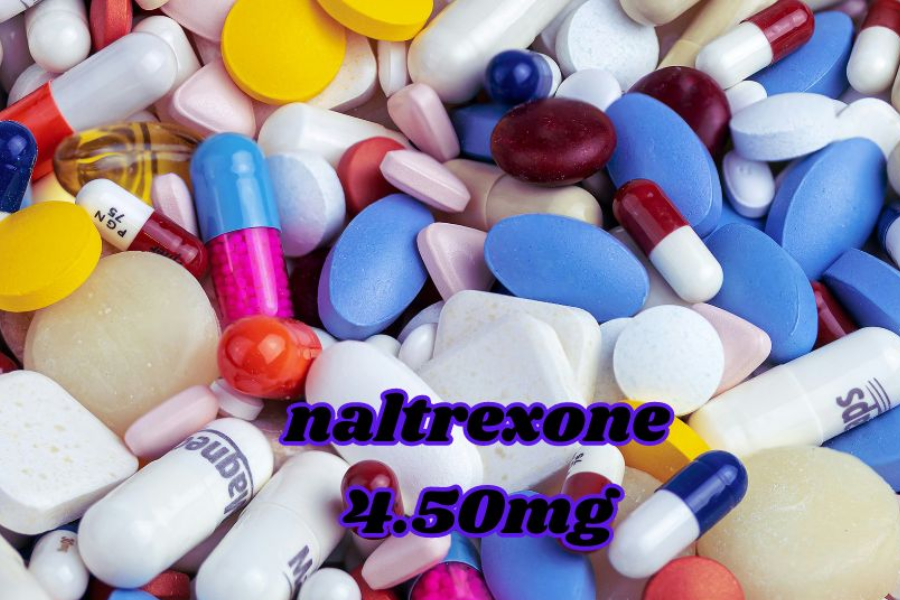Naltrexone 4.50mg Side Effects Explained: From Fatigue to Nausea and Beyond
Introduction
Feeling unusually tired while taking Naltrexone 4.50mg? You’re not alone. Many people experience significant fatigue as a side effect of this medication, which is primarily prescribed to aid in managing addiction and supporting recovery from alcoholism. Gaining a deeper understanding of how Naltrexone works, along with its benefits and potential side effects, can help you navigate your path to better health more effectively.
This comprehensive guide will shed light on why you might feel excessively tired while using Naltrexone 4.50mg. Whether you’re currently on this medication or contemplating its use in your treatment plan, you’ll find essential information here to help you address and manage these feelings of fatigue. Let’s explore the details of Naltrexone and uncover what you need to know for a smoother experience.
Naltrexone 4.50mg Side Effects
When using Naltrexone 4.50mg, being aware of possible side effects is crucial. A frequent issue reported by users is severe fatigue, which can greatly affect daily activities and might necessitate changes in your routine.
Other side effects you might encounter include nausea and headaches, which are common as your body adjusts to the medication. Some users also experience dizziness or disturbances in sleep.
It’s important to keep track of how you feel after starting Naltrexone. If persistent or worsening fatigue becomes a concern, it’s a good idea to consult with a healthcare provider. They can assess whether a dosage adjustment is needed or if an alternative treatment might be more appropriate for you.
Being informed about these side effects allows you to make educated choices about your health while using Naltrexone 4.50mg.
What is Naltrexone 4.50mg?
Naltrexone is primarily used to address alcohol and opioid dependence. However, at lower doses, such as 4.50mg, it is frequently prescribed off-label for various conditions including fibromyalgia, chronic pain, and autoimmune disorders. This lower dosage is commonly known as Low Dose Naltrexone (LDN).
How Does Naltrexone Work?
Naltrexone operates by blocking opioid receptors in the brain, which helps to lessen cravings and withdrawal symptoms for individuals dealing with addiction. When used in lower doses, it is thought to help regulate the immune system and reduce inflammation, potentially providing relief for chronic pain and autoimmune conditions.
What is Naltrexone 4.50mg extremely tired?
Naltrexone 4.50mg is commonly prescribed to manage alcohol dependence and opioid addiction. It works by blocking opioid effects in the brain, helping to reduce cravings and withdrawal symptoms.
For many users, experiencing significant fatigue while on this dosage can be troubling. This tiredness might be related to how Naltrexone interacts with your body’s chemistry, as individual reactions to medications can vary widely.
In some cases, fatigue could also be influenced by underlying health conditions or other medications being taken at the same time. It’s important to consider these factors when evaluating your overall well-being while on Naltrexone.
Understanding that fatigue may be a direct result of this treatment helps individuals make better-informed decisions about their health and future treatment options.
Uses of Naltrexone 4.50mg Extremely Tired
Naltrexone 4.50mg is primarily prescribed to assist individuals struggling with alcohol dependence by blocking the pleasurable effects of alcohol, which helps reduce cravings and support abstinence.
This medication is also effective in treating opioid addiction. It works by diminishing the high from opioids, aiding patients in resisting the urge to misuse these substances.
Additionally, Naltrexone has shown potential in addressing certain behavioral issues related to food cravings and obesity. Research indicates that it may help manage appetite and curb binge-eating behaviors.
For many, adding Naltrexone to their recovery plan can be a crucial step toward regaining control of their lives. Its diverse applications make it a valuable tool in various therapeutic contexts.
Common Side Effects of Naltrexone 4.50mg
Naltrexone is typically well-tolerated, particularly at lower doses such as 4.50mg. Nonetheless, some users might experience side effects. Here are a few of the most frequently reported ones:
1. Nausea
Nausea is a frequent side effect of naltrexone, but it is usually mild and often diminishes as you continue using the medication.
2. Headache
Headaches can sometimes occur, especially during the early days of starting the medication.
3. Dizziness
Some people might experience lightheadedness or dizziness after taking naltrexone, particularly when standing up quickly.
4. Fatigue
Unusual fatigue is another potential side effect that some individuals may experience, especially during the initial weeks of treatment.
5. Insomnia
Some individuals may experience difficulty sleeping or insomnia, particularly when they first begin taking naltrexone.
Managing Side Effects
Effectively managing the side effects of Naltrexone 4.50mg involves several key strategies:
Stay in Touch with Your Healthcare Provider: Regular communication with your healthcare provider is vital. Discuss any side effects you experience to ensure they are properly monitored and addressed.
Follow Dosage Guidelines: Adhering to the prescribed dosage is important to minimize side effects. Avoid alcohol and opioids during your treatment to prevent negative interactions.
Adopt a Healthy Lifestyle: Making healthy lifestyle choices can alleviate many common side effects. Focus on eating a balanced diet, staying hydrated, exercising regularly, and getting enough rest.
Long-Term Use Considerations
If you’re thinking about using Naltrexone 4.50mg for an extended period, it’s crucial to be aware of potential long-term side effects. Regular check-ups with your healthcare provider and routine health evaluations can help detect and manage any adverse effects early.
Maintaining open communication with your healthcare team is essential. Report any new or worsening symptoms promptly to ensure that issues are addressed before they become more serious. This proactive approach helps in preventing more significant complications.
Benefits of Naltrexone 4.50mg extremely tired for Alcoholism
Naltrexone 4.50mg provides significant benefits for individuals struggling with alcoholism. By blocking the pleasurable effects of alcohol, it helps reduce cravings and enables users to regain control over their drinking habits.
The medication can improve mood and mental clarity by lessening the urge to drink. Many users find themselves feeling more emotionally stable, which helps them handle daily challenges without relying on alcohol.
Incorporating Naltrexone into a treatment plan can also boost participation in therapy and support groups. It fosters a stronger commitment to recovery by making sobriety feel more achievable.
Furthermore, using Naltrexone encourages healthier lifestyle choices, as individuals shift their focus from drinking to their overall well-being. This change supports lasting recovery and contributes positively to their overall health.
Alternatives to Naltrexone 4.50mg extremely tired for Treating Alcohol
When exploring alternatives to Naltrexone 4.50mg for treating alcohol dependence, several effective options are available:
Acamprosate: This medication works by helping to restore the balance of neurotransmitters in the brain after prolonged alcohol use.
Disulfiram: Known by its brand name Antabuse, this drug causes unpleasant reactions when alcohol is consumed, which can motivate individuals to abstain from drinking.
Counseling and Behavioral Therapies: Approaches like Cognitive Behavioral Therapy (CBT) are useful for addressing and changing harmful thought patterns related to alcohol use.
Support Groups: Community-based programs such as Alcoholics Anonymous offer encouragement and shared experiences that can be beneficial during the recovery process.
Mindfulness and Holistic Approaches: These methods focus on improving overall well-being by addressing both mental health and lifestyle changes, which can support efforts to reduce or eliminate alcohol consumption.
Conclusion
Navigating the side effects of Naltrexone 4.50mg, particularly fatigue, is an important aspect of managing your treatment effectively. Understanding the potential side effects, including nausea, headaches, dizziness, and unusual tiredness, helps you make informed decisions about your health and how to address any issues that arise. Regular communication with your healthcare provider, following prescribed dosages, and adopting a healthy lifestyle are key strategies for managing these side effects. While Naltrexone can be a powerful tool in treating alcoholism and other conditions, it’s essential to monitor how it affects you personally and explore alternatives if necessary. By staying informed and proactive, you can better navigate your path to recovery and overall well-being.
FAQs
1. What should I do if I experience excessive fatigue while taking Naltrexone 4.50mg?
If you experience significant fatigue, it’s important to consult with your healthcare provider. They can assess whether the fatigue is related to the medication, suggest dosage adjustments, or explore alternative treatments that might better suit your needs.
2. Are there any other common side effects associated with Naltrexone 4.50mg?
Yes, besides fatigue, common side effects of Naltrexone 4.50mg include nausea, headaches, dizziness, and insomnia. Most side effects are mild and may diminish over time, but it’s essential to report any persistent issues to your healthcare provider.
3. How can I manage the side effects of Naltrexone 4.50mg?
Managing side effects involves regular communication with your healthcare provider, adhering to prescribed dosages, and adopting a healthy lifestyle. Maintaining a balanced diet, staying hydrated, and ensuring adequate rest can help alleviate some side effects.
4. Are there alternatives to Naltrexone 4.50mg if the side effects are too severe?
Yes, alternatives to Naltrexone 4.50mg include medications like Acamprosate and Disulfiram, as well as non-pharmacological approaches such as counseling, behavioral therapies, and support groups. Discuss these options with your healthcare provider to find the best fit for your treatment plan.
5. How can I know if Naltrexone 4.50mg is working for me?
You can evaluate the effectiveness of Naltrexone 4.50mg by monitoring changes in your cravings and withdrawal symptoms related to alcohol or opioid use. Improved mood, mental clarity, and reduced urge to drink or use opioids are positive indicators. Regular follow-ups with your healthcare provider will help assess progress and make any necessary adjustments to your treatment.
Stay informed with the latest news and updates on Times Cycle






